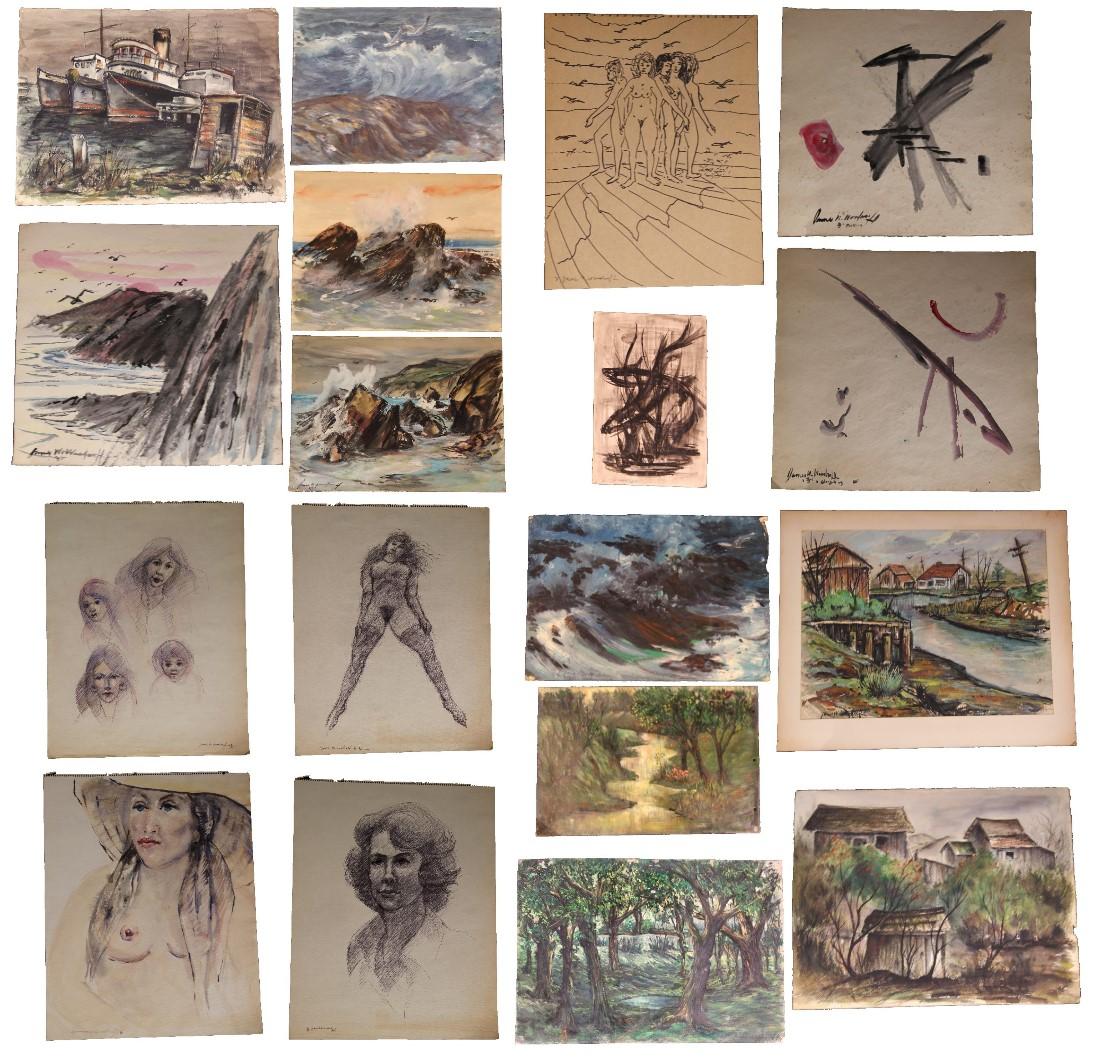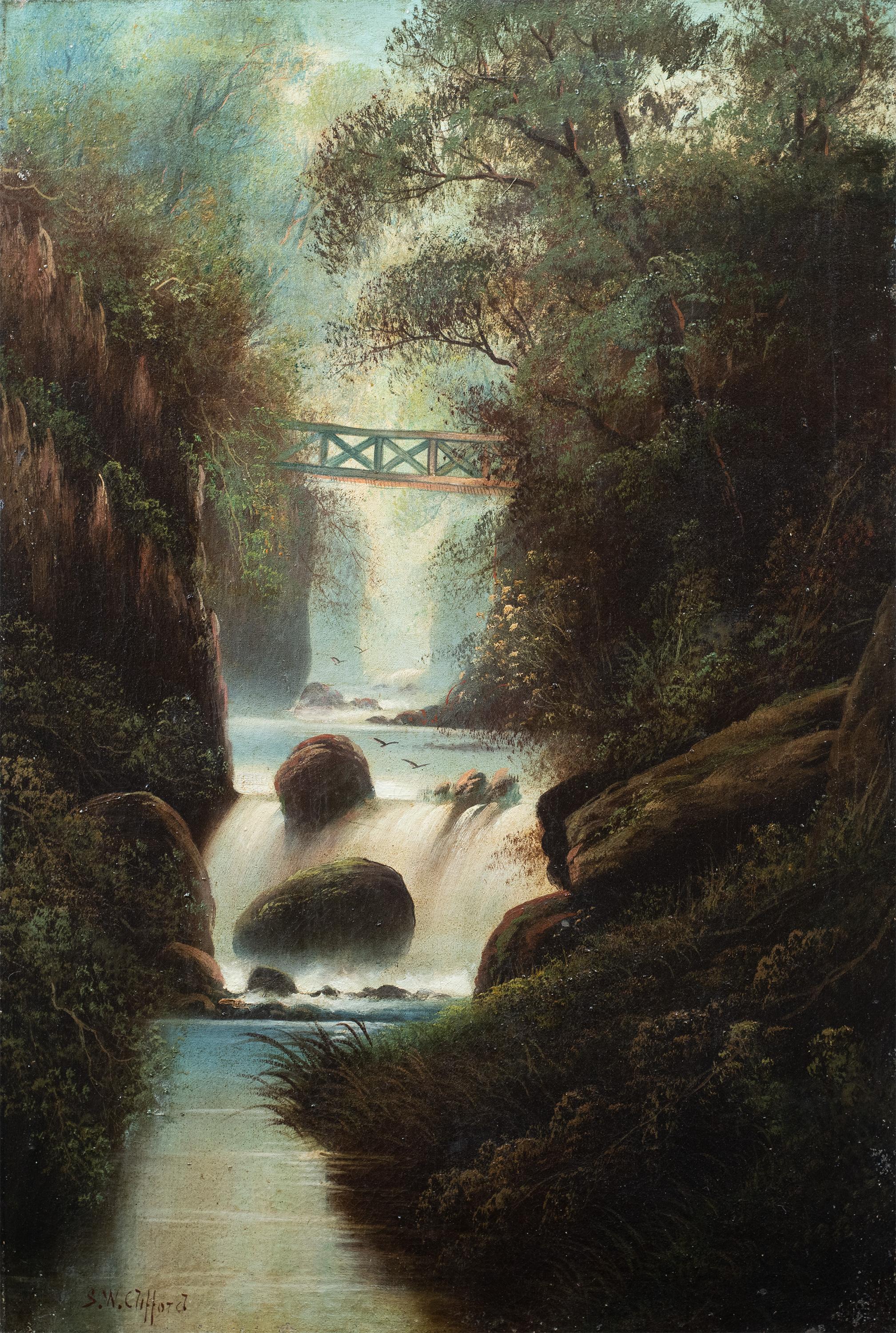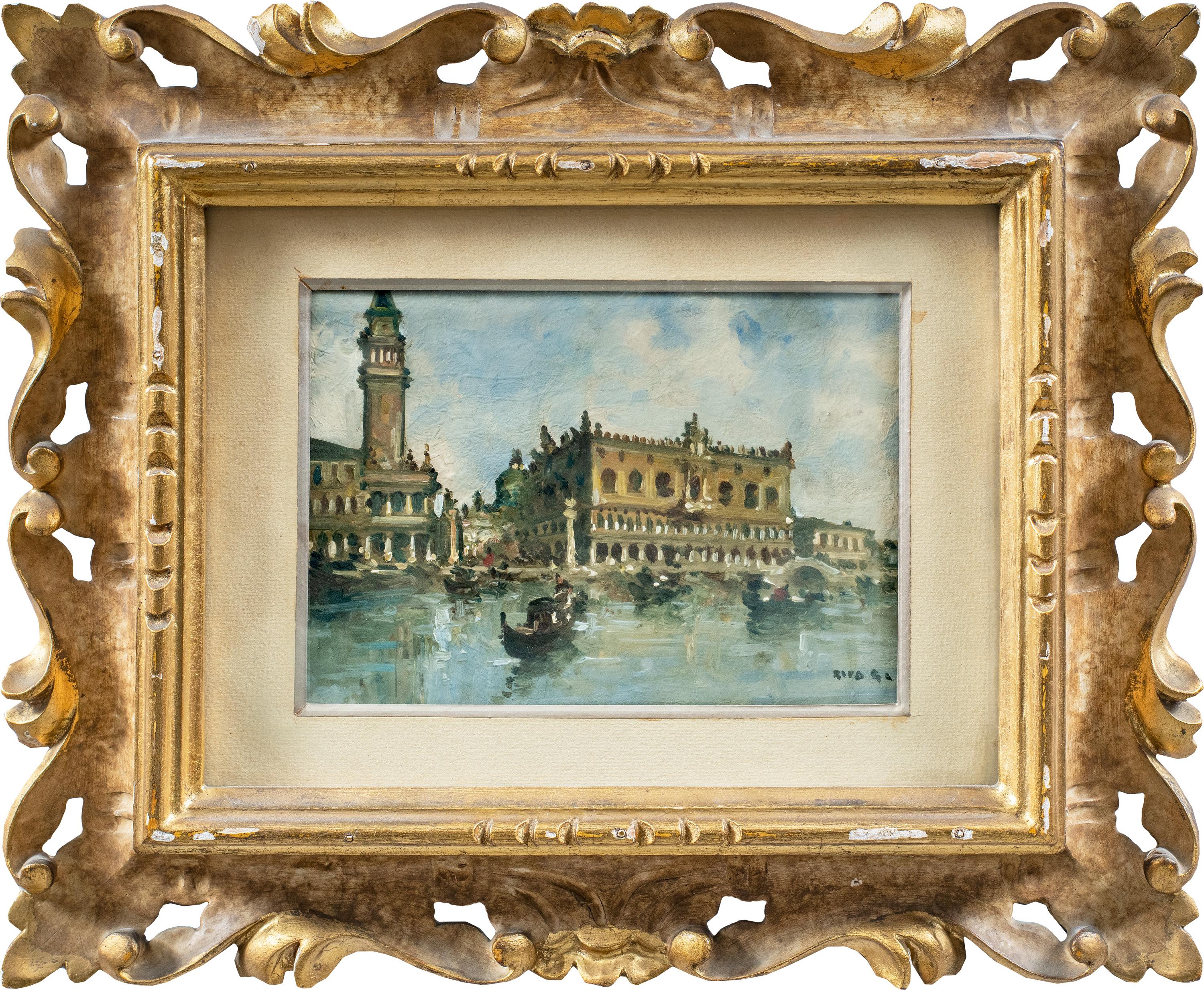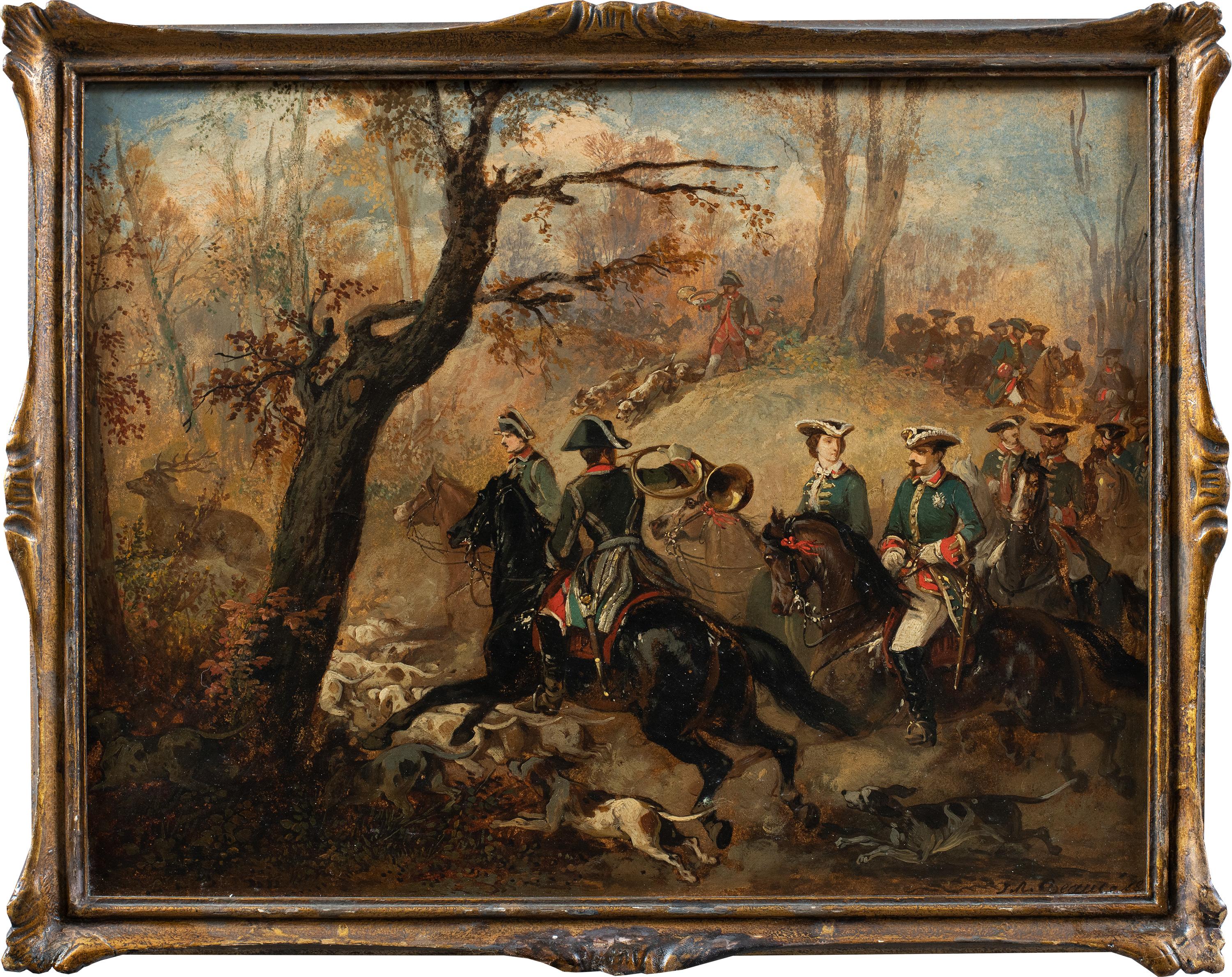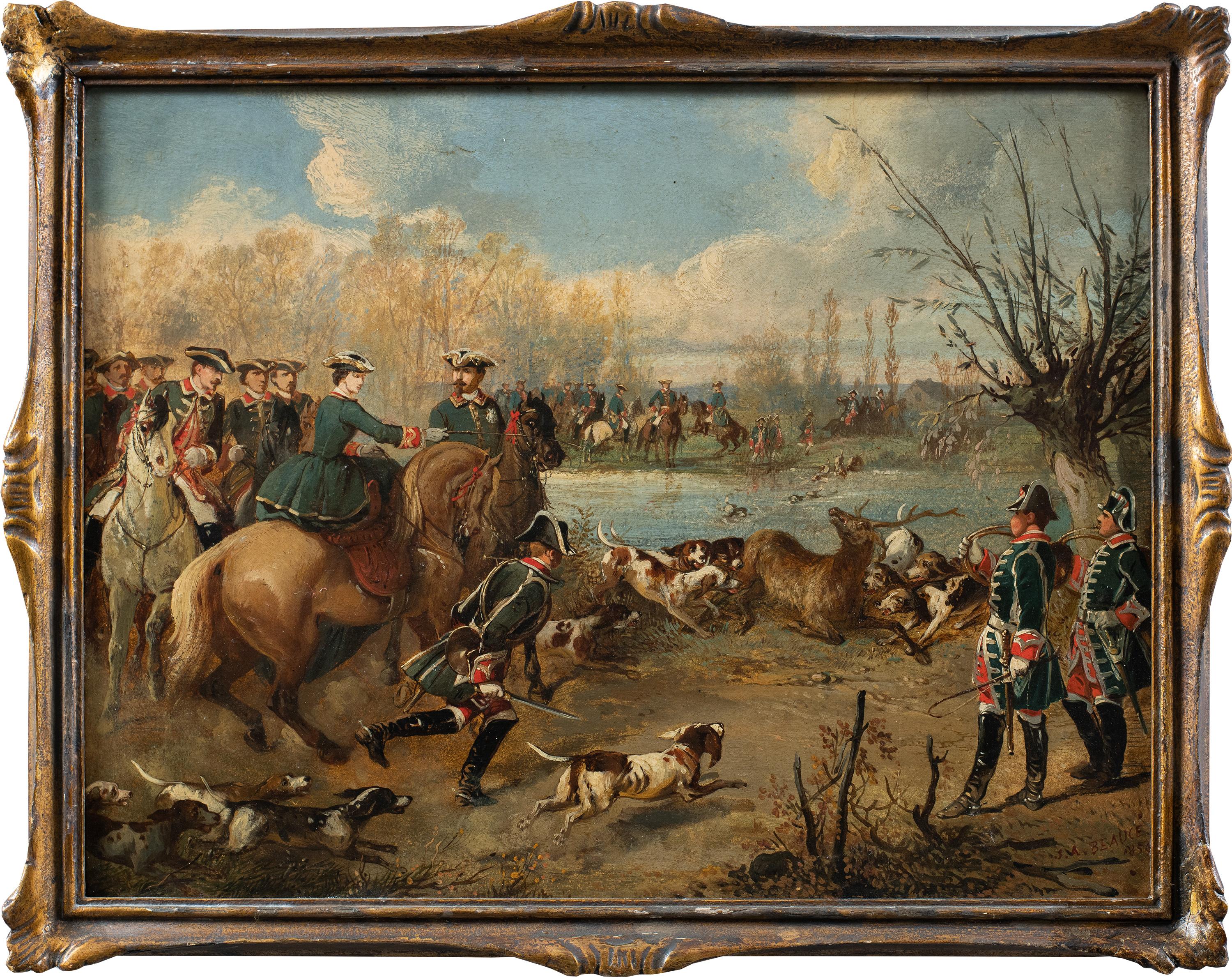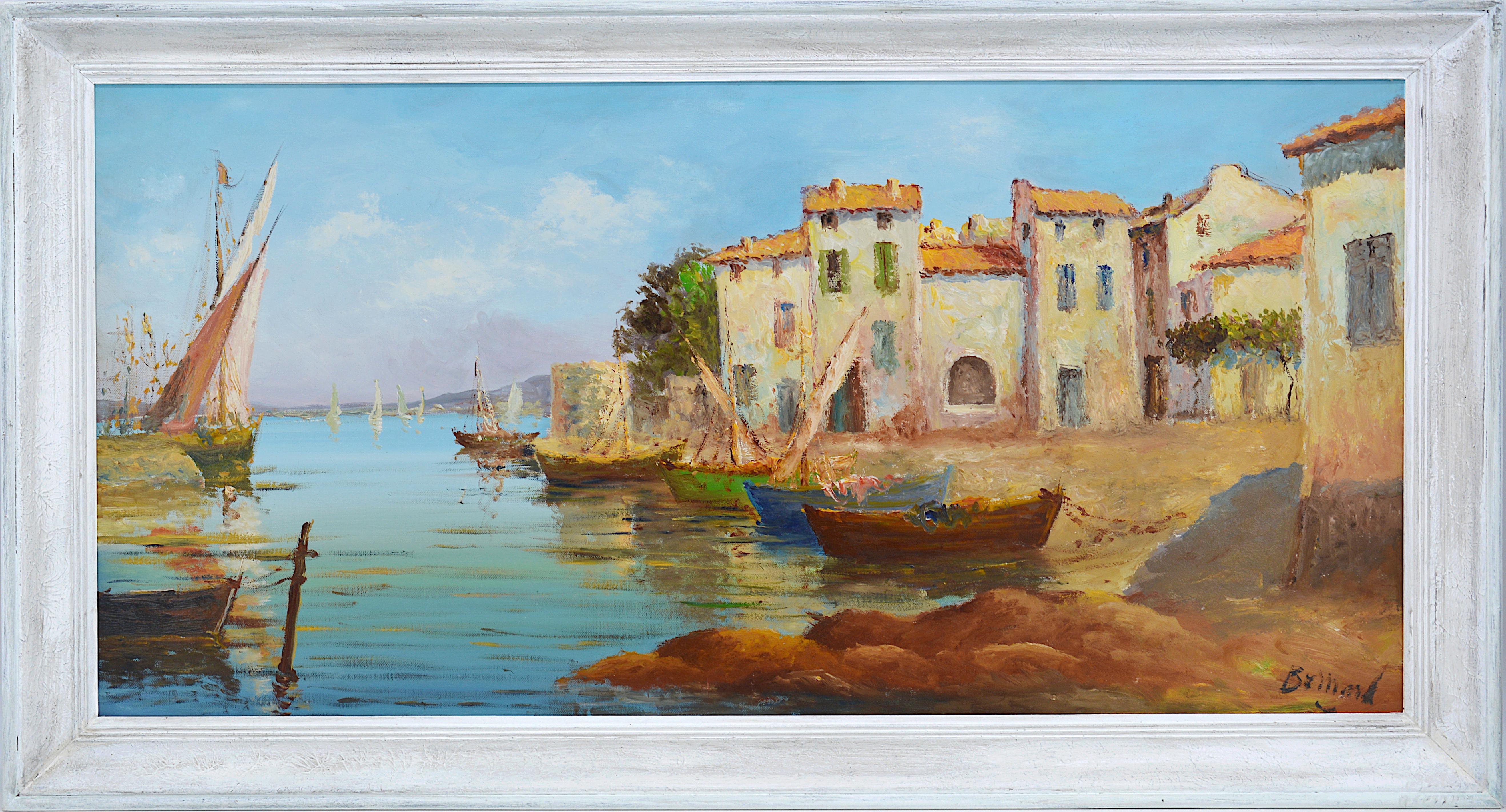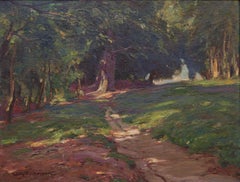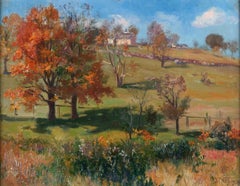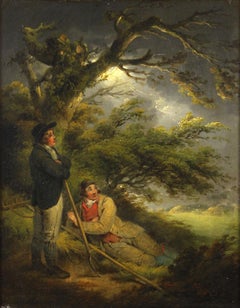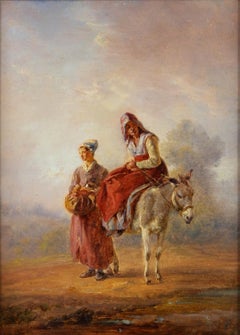
Park landscape with full moon / - The path into the light -
View Similar Items
Want more images or videos?
Request additional images or videos from the seller
1 of 5
Johann JungblutPark landscape with full moon / - The path into the light -c. 1910
c. 1910
About the Item
- Creator:Johann Jungblut (1860 - 1912, German)
- Creation Year:c. 1910
- Dimensions:Height: 12.6 in (32 cm)Width: 9.06 in (23 cm)
- Medium:
- Movement & Style:
- Period:
- Condition:
- Gallery Location:Berlin, DE
- Reference Number:1stDibs: LU2438215042162
Johann Jungblut
Johann Jungblut was a German painter who focused on depicting winter landscapes of rural Netherlands, Germany, and Norway. Jungblut painted in a style which merged Impressionist techniques with the tradition of Dutch landscape painters like Aelbert Cuyp, Meindert Hobbema, and Jacob van Ruisdael. Jungblut’s icy landscapes are contrasted with works by Hans Thoma, a fellow German painter who portrayed pastoral vistas in a similar impressionist style. Both artists are expressive of Germany’s artistic tradition of immortalizing the Germanic landscape. Jungblut’s works are in the collection of The Institute in Keith, United Kingdom. The artist died on December 17, 1912 in Düsseldorf, Germany. E. Bénézit, DICTIONNAIRE DES PEINTRES, SCULPTEURS, DESSINATEURS ET GRAVEURS

About the Seller
5.0
Gold Seller
Premium sellers maintaining a 4.3+ rating and 24-hour response times
Established in 2014
1stDibs seller since 2023
16 sales on 1stDibs
Typical response time: 6 hours
Authenticity Guarantee
In the unlikely event there’s an issue with an item’s authenticity, contact us within 1 year for a full refund. DetailsMoney-Back Guarantee
If your item is not as described, is damaged in transit, or does not arrive, contact us within 7 days for a full refund. Details24-Hour Cancellation
You have a 24-hour grace period in which to reconsider your purchase, with no questions asked.Vetted Professional Sellers
Our world-class sellers must adhere to strict standards for service and quality, maintaining the integrity of our listings.Price-Match Guarantee
If you find that a seller listed the same item for a lower price elsewhere, we’ll match it.Trusted Global Delivery
Our best-in-class carrier network provides specialized shipping options worldwide, including custom delivery.More From This Seller
View AllForest landscape bathed in sunlight / - The Monumentality of the Forest -
Located in Berlin, DE
Wilhelm Feldmann (1859 Lüneburg - 1932 Lübeck), Sunny forest landscape, c. 1900. Oil on canvas, marouflaged on wood, 37 cm x 48 cm (inside dimensions), 42.5 cm x 53.5 cm (frame), sig...
Category
Early 1900s Impressionist Landscape Paintings
Materials
Oil
Autumn Landscape in Sunlight - Indian Summer -
Located in Berlin, DE
Frederick Vezin (1859 Torresdale Philadelphia - 1933 Düsseldorf), Autumn Landscape in the Sunlight, oil on canvas, mounted on cardboard, 32 x 41 cm (inside measurement), 44 x 51 cm (frame), signed and dates lower right "F. Vezin. [19]05".
- Cardboard slightly curved, small inconspicuous retouch at the centre of the upper edge of the picture.
About the artwork
Although the painting appears to be a sketch, Frederick Vezin considered it to be a finished work of art, as evidenced by his signature on the lower right. And it is precisely this sketchy quality that leads to an understanding of the painting, which was certainly created in the landscape itself: the natural phenomena were to be depicted artistically at the moment of their observation. This is not done by meticulously sketching nature, but - and here Vezin follows the teaching of French Impressionism - by illustrating nature in its visual fullness. The artist's eye is, as it were, immersed in the visuality of nature, which is made visible by his hand. The painting is therefore not a reflection of the landscape, but its artistic intensification.
This intensification also includes the fact that the foreground of the painting - corresponding to the field of vision - eludes a detail-oriented close-up view. Instead, the spatula-like application of paint, the vertical structure of which corresponds to the structure of the floral growth, has the effect of making nature tangible in its colourful substance.
At the same time, the foreground, which remains indeterminate in its concrete objectivity, creates an atmospheric space that connects with the actual protagonist of the picture, the group of trees, which flares up in shades of red and brown. Here, too, the leaves are more speckled than clearly outlined. It is precisely this 'sketchiness' that opens up a visual experience that makes the landscape accessible in its visual fullness, thus revealing its essence.
In addition to this abundance, the landscape is presented as a structure of order in that the composition of the picture makes the composition of the landscape visible. For example, the group of trees forms a distinct dark green shadow, which is repeated in the shadows cast by the trees behind it. A patterned diagonal axis is created in the picture, which is composed in this way by the landscape itself.
Strictly speaking, this is a cultivated landscape: a fence at the bottom and a low stone wall at the top, running from left to right, are two elements that also have a strong compositional effect. And on the top of the hill, a stone house is embedded in the landscape as the brightest surface in the picture. Nature and culture here form a harmonious synthesis, giving the painting an Arcadian touch.
In order to give the landscape as much space as possible, the horizon line is raised, but the design of the sky is also crucial. The clouds, combined with the shapes of the trees, create a bright blue sky. To the European eye, such a sky is reminiscent of a summer landscape. Accordingly, within the seasonal cycle, the blue sky is reserved for summer, and French Impressionism is also primarily an ode to summer. In Vezin's painting, however, the brilliant blue sky stands above an autumnal landscape, some of the trees even defoliated. It can therefore be assumed that the painting was made not in Europe but in the United States, and that it illustrates the proverbial Indian summer, making Frederick Vezin a pioneer of American landscape painting.
About the artist
Frederick Vezin was the son of a French immigrant to the United States and a German-born mother. This predestined him to promote artistic exchange between the old and new worlds. Having spent part of his schooling in Germany, in 1876, at the age of 20, he enrolled at the Düsseldorf Academy of Art, where he studied with Peter Janssen the Elder, Eduard von Gebhardt and Wilhelm Sohn, among others. He graduated in 1883, settled in Munich and returned to Düsseldorf in 1895, where he lived until his death in 1933.
A native of the United States, he travelled to the country frequently and became a popular portrait and society painter. His artistic talent, however, was most evident in his landscape paintings. Trained in French Impressionism, he developed a virtuoso use of colour and a free brushwork that remained tied to the landscape motif, opening up the landscape itself in a new way. Frederick Vezin turned his attention primarily to the landscape of his homeland, becoming a pioneer of modern American landscape...
Category
Early 1900s Impressionist Landscape Paintings
Materials
Cardboard, Oil
$2,031 Sale Price
20% Off
Sheltering from the storm / - Romantic landscape illuminated by lightning bolt -
By George Morland
Located in Berlin, DE
George Morland (1763 London - 1804 Brighton). Sheltering from the Storm. Oil on canvas, relined, 37.5 x 29.5 cm (visible size), 53.5 x 45.5 cm (...
Category
1790s Romantic Landscape Paintings
Materials
Oil
Two countrywomen with a donkey - Melancholy in an atmosphere of colour -
Located in Berlin, DE
Pierre Louis De La Rive (1753 Geneva - 1817 Geneva). Two countrywomen with a donkey. Oil on canvas, mounted, 27 x 20 cm (visible size), 37 x 31 (frame), monogrammed "P.R." at lower right.
About the artwork
De La Rive has taken the typical scenes of Dutch landscape genre paintings...
Category
1790s Old Masters Figurative Paintings
Materials
Oil, Canvas
Impressionist Autumn Landscape with Lake / - Diffuse Concretion -
Located in Berlin, DE
Wilhelm Feldmann (1859 Lüneburg - 1932 Lübeck), Impressionist autumn landscape with lake, around 1905. Pastel on cardboard, 46 cm x 31 cm (inside dimension), 52 cm x 37 cm (frame), s...
Category
Early 1900s Impressionist Landscape Paintings
Materials
Gouache
Late Summer River Landscape / - Realistic Impression -
By Jan Hillebrand Wijsmüller
Located in Berlin, DE
Jan Hillebrand Wijsmuller (1855 Amsterdam - 1925 ibid.), Late Summer River Landscape, oil on canvas, relined, 34 x 56 cm (inside measurement), 43 x 64 cm (frame), signed J[an] H[illebrand] Wijsmuller at lower right.
- in good condition, the frame with isolated bumped spots
- Realistic Impression -
About the artwork
The panoramic landscape format shows a river landscape, with the course of the river, which curves to the right, leading the eye into the depths of the picture and tempting it to continue the landscape in the imagination beyond the visible area. At the same time, however, the fact that the landscape is not visible through the bend in the river focuses our gaze on the entirety of the landscape depicted, without prompting us to focus on distant details. Accordingly, the brushstroke is not designed to render details with realistic precision. In the front left area of the river there is even a completely free brushwork, trained by Impressionism, which nevertheless remains committed to representational and convincingly suggests the movement of the water.
Regardless of the distance of the observer, the entire picture is painted with the same broad brushstroke, so that the landscape is given as an impression. And yet this impression is not ephemeral, as in the case of French Impressionism, to put it exaggeratedly, but reveals to us the essence of the landscape in all its richness. This is why the Dutch variant of Impressionism is always also a realism, although the pictures appear less progressive, but still contain a dimension of landscape painting that is lost with progress.
In the impression, the reality of the landscape is revealed, and this happens as we experience the landscape in the visual impression. Wijsmuller does not depict houses or people in order to allow the experience of the landscape to fully unfold. The experience is determined first and foremost by the river, which does not flow into the picture from our point of view, but towards us. Where the river begins to bend, the water is churned by a rapids. Toward us, the riverbed widens and the water comes to rest, covering the entire width of the foreground like a mirror.
The stillness of the water corresponds to the evening mood of the late summer landscape, in which the warm tones of the evening light blend with the yellow and brown tones of the plants. A gentle, almost idyllic reality, carried by the brushstroke, yet animated by a liveliness that is also made visible by the brushstroke. The broad, dynamically placed brushstrokes evoke the movement of the treetops and animate even the immobile reeds, while the trunks on the right bank, executed in virtuoso white strokes that seem like markings, make the sunlight shine. On the other bank, a carpet of light also spreads out, its energetic effect again expressed in the brushstroke. The dynamic of the landscape is further enhanced by the complementary color contrasts between the greens, yellows, and browns on the one hand and the blue of the all-encompassing sky on the other. A contrast that is intensified by the reflection in the water.
The evening coming to rest of the landscape is thus at the same time an all-encompassing contrasting and yet in itself harmonious movement. This reality becomes accessible to us as an experience in the impression of the landscape.
About the artist
Jan Hillebrand Wijsmuller entered the Royal Academy of Arts in Amsterdam in 1876 and studied under the innovative Professor August Allebé, who was famous for the Amsterdam Impressionism, also known as the Allebé School.
In 1877, Wijsmuller transferred to the Hague Academy of Art, and thus to the Hague School, and then completed his studies at the Brussels Academy of Art. Returning to the Netherlands, Wijsmuller opened his own studio in Amsterdam.
In 1883 he won the prestigious Young Artist Award, donated by Willink van Collen, which made Wijsmuller a well-known and sought-after artist.
Wijsmuller was a member of the Societät Arti et Amicitiae Amsterdam and the Pulchri Studio in The Hague.
Wijsmuller belongs to the second generation of the Hague School. While Vincent van Gogh described the protagonists of the first generation to his brother Theo as "the great gray people," the second generation, and Wijsmuller in particular, used a much more colorful palette. His oeuvre makes him a major player in Dutch Impressionism...
Category
1890s Impressionist Landscape Paintings
Materials
Canvas
$3,508 Sale Price
20% Off
You May Also Like
Waterfront Farm, original oil on canvas, C19th, naturalistic style
By Louis Dubois
Located in Naples, Florida
This beautiful oil-on-panel painting of a tranquil waterfront farm that is over 120 years old is by the Belgian painter Louis Dubois (1830–1880).
Dubois...
Category
Mid-19th Century Naturalistic Landscape Paintings
Materials
Canvas, Oil
"Catalonia Landscape", Early 20th Century Oil on Canvas by Modest Urgell
Located in Madrid, ES
MODEST URGELL
Spanish, 1839 - 1919
CATALONIA LANDSCAPE
signed “Urgell” (lower left)
oil on canvas
27-1/4 x 51-1/4 in. (69 x 130 cm.)
framed: 31-1/4 x 55-...
Category
Early 1900s Naturalistic Landscape Paintings
Materials
Canvas, Oil
Naturalistic Field with Trees Landscape
By Anthony V. Martin
Located in Houston, TX
Naturalistic landscape painting of a field of trees painted with egg tempera. The piece is signed by the artist in the bottom corner and framed in a dark wooden frame with black acce...
Category
1970s Naturalistic Landscape Paintings
Materials
Oil
Idealized Forest Hunting Scene
By Peggy Byars
Located in Houston, TX
Landscape painting of a forest with hunters and their dog. The work is signed by the artist in the bottom corner. The canvas is framed in a gold frame with a black trim.
Dimensions Without Frame: H 24 in x W 30.25 in. x D 1 in.
Artist Biography: Texas artist, Peggy Byars, has been a professional artist since 1976. She feels that a work of art should involve the total person. One should sense the smells, feel the warmth of the sun, enjoy the fresh air and cold water hear the wildlife. Peggy's illumination technique, or glow, is the trademark of all her work, giving her paintings a refreshing aliveness and sense of being there.
Ms. Byars has studied with Cowboy Artists of America Museum in Kerrville: Harvey...
Category
20th Century Naturalistic Landscape Paintings
Materials
Oil
Lot of 17 James Woodruff Landscape, Abstract and Figurative Paintings
By James W. Woodruff
Located in Houston, TX
Lot of seventeen different paintings by artist James Woodruff. Includes four landscape paintings, six seascape paintings, two abstract paintings the la...
Category
20th Century Naturalistic Landscape Paintings
Materials
Oil, Graphite
Naturalistic Landscape with Figures on a Boat
Located in Houston, TX
Oil painting of a river landscape with figures in a boat rowing along the foreground. The work is painted on board. It is framed in a decorative frame.
Dimensions without frame: H 24 in x W 36 in.
Artist Biography: William Joseph Shayer, senior was a self-taught artist, who began by painting decorations on rush-bottom chairs. He moved on to painting carriages in the town of Guildford, after which he started doing heraldic painting...
Category
19th Century Naturalistic Landscape Paintings
Materials
Oil
Recently Viewed
View AllMore Ways To Browse
Fairy Castle
Spotted Fur
German Mettlach
Antique Villeroy And Boch Mettlach
Von Hohen
Hans Canon
Jungblut Johann
Hugh Church
Italian Landscape Painting 19th Century G
J Richardson
Louis Dupre
Painting French Naval Battle
Rain Hopper
Rene Guinand
Scottish Knife
Sydney Harbour
Thomas Churchyard
Vintage European Cityscapes
